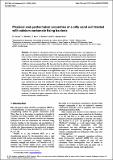Por favor, use este identificador para citar o enlazar a este item:
http://hdl.handle.net/10261/221995COMPARTIR / EXPORTAR:
 SHARE SHARE
 CORE
BASE CORE
BASE
|
|
| Visualizar otros formatos: MARC | Dublin Core | RDF | ORE | MODS | METS | DIDL | DATACITE | |

| Título: | Physical and geotechnical properties of a silty sand soil treated with calcium carbonate fixing bacteria |
Autor: | Garzón Garzón, Eduardo; Morales, Rafael CSIC ORCID; Romero, Esperanza CSIC ORCID; Sánchez-Soto, Pedro José CSIC ORCID | Fecha de publicación: | 2020 | Editor: | EDP Sciences | Citación: | E3S Web of Conferences 195, 05002 (2020) | Resumen: | The objective of the present study is to develop a biotechnological tool for a new application of silty sand soil as stabilized materials in linear works replacing chemical stabilizer (e.g. cement and lime) by natural cement, formed by precipitated calcium carbonate generated by microorganisms of the Sporosarcina family. For this purpose, it is conducted a chemical and mineralogical characterization and an examination of physical and geotechnical properties, being very important from the engineering standpoint. The results of different tests are presented here. The data show that the effects of bacteria are reducing the soil specific surface and increasing its plasticity. The reason for this result could be the addition of a plastic component to the natural soil, or the result of the more aggregated structure promoted during the treatment. The pore size distribution of the soil changes in an approximate range 3 - 30 μm, where the pore mode tends to disappear. The change in the pore density function is reflected in the mechanical behaviour of the treated soil, which presents typical features of a less dense soil with respect to the natural untreated one. The friction angle of the treated soil is slightly higher, and its compressibility is consistently lower than that of the natural soil. As the bacteria do not seem to produce any cementation effect on the soil skeleton, collapse upon wetting does not seem to be significantly affected by the treatment. On the contrary, comparison of collapse data shows that occurrence and amount of collapse are ruled by the as-compacted dry density. The tests performed seem to suggest that the microbiological technique may be effective to improve the mechanical characteristics of the compacted soil. For that, it is necessary to provide more energy in compacting the treated soil that it will be stabilized, so as to achieve a high initial dry density. From this viewpoint, it seems that higher compaction effort is even more effective than increasing the amount of bacteria introduced to stabilize the soil. | Versión del editor: | https://doi.org/10.1051/e3sconf/202019505002 | URI: | http://hdl.handle.net/10261/221995 | DOI: | 10.1051/e3sconf/202019505002 |
| Aparece en las colecciones: | (ICMS) Artículos |
Ficheros en este ítem:
| Fichero | Descripción | Tamaño | Formato | |
|---|---|---|---|---|
| e3sconf_e-unsat2020_05002.pdf | 1,75 MB | Adobe PDF |  Visualizar/Abrir |
CORE Recommender
Page view(s)
130
checked on 16-may-2024
Download(s)
118
checked on 16-may-2024
Google ScholarTM
Check
Altmetric
Altmetric
NOTA: Los ítems de Digital.CSIC están protegidos por copyright, con todos los derechos reservados, a menos que se indique lo contrario.
